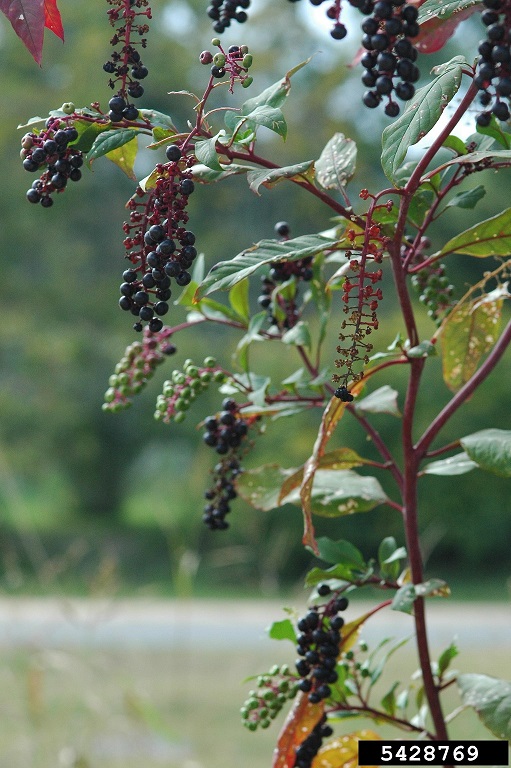Phytolacca americana
| Phytolacca americana | |
|---|---|

| |
| Photo by Karan A. Rawlins, University of Georgia, Bugwood.org | |
| Scientific classification | |
| Kingdom: | Plantae |
| Division: | Magnoliophyta - Flowering plants |
| Class: | Magnoliopsida – Dicotyledons |
| Order: | Caryophyllales |
| Family: | Phytolaccaceae |
| Genus: | Phytolacca |
| Species: | P. americana |
| Binomial name | |
| Phytolacca americana L. | |

| |
| Natural range of Phytolacca americana from USDA NRCS Plants Database. | |
Common names: American pokeweed; Common pokeweed; Poke; Pokeberry[1]
Contents
Taxonomic notes
Synonyms: none.[1]
Description
A description of Phytolacca americana is provided in The Flora of North America. It is a robust, perennial herb that grows 1-3 m tall. The roots are thick and fleshy. The leaves have an alternate pattern, glabrous texture, entire margin, and lanceolate to elliptic shape. They grow 3-12 cm wide and 8-30 cm long with a rounded base. The petioles are 1-5 cm long. Racemes are 5-20 cm with bracteate pedicels. The flowers are perfect, colored green to white, and 2-3 mm long. They include 5 sepals, 5-30 stamens, and a superior ovary. The berries are 5-12 carpellate, purplish-black, 4-6 mm long, and 7-10 mm in diameter. The seeds are lustrous black, 2.5-3 mm long, and flattened.[1]
Distribution
This plant is an abundant native weed that occurs throughout eastern North America.[1]
Ecology
This plant flowers from May through November.[1]
Pollination
The following Hymenoptera families and species were observed visiting flowers of Phytolacca americana at Archbold Biological Station: [2]
Apidae: Bombus impatiens
Halictidae: Augochlora pura, Augochlorella striata, Augochloropsis metallica, A. sumptuosa, Lasioglossum lepidii, L. miniatulus, L. nymphalis, L. pectoralis, L. placidensis, L. puteulanum
Megachilidae: Heriades leavitti
Sphecidae: Ectemnius maculosus, E. rufipes ais, Isodontia exornata, Oxybelus laetus fulvipes
Vespidae: Leptochilus alcolhuus, L. republicanus, Polistes dorsalis hunteri, Zethus slossonae
Conservation and management
Cultivation and restoration
Photo Gallery
References and notes
- ↑ 1.0 1.1 1.2 1.3 1.4 1.5 1.6 Weakley, A.S. 2015. Flora of the southern and mid-atlantic states. Working Draft of 21 May 2015. University of North Carolina at Chapel Hill, Chapel Hill, North Carolina.
- ↑ Deyrup, M.A. and N.D. 2015. Database of observations of Hymenoptera visitations to flowers of plants on Archbold Biological Station, Florida, USA.